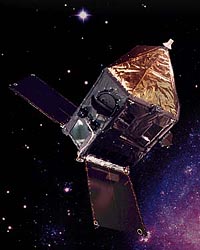Hipparcos
For a satellite that seemed plagued with problems from the start, the small Hipparcos satellite has made large contributions to the measurement of astronomical distances by making much more accurate stellar parallax measurements than could be made from Earth.
The Hipparcos satellite contains a small 29-cm mirror designed to measure the positions of stars very accurately. It's parallax measurements are at least 10 times greater in accuracy than measurements from the Earth's surface. It's mission was to measure accurate distances of nearly a million stars out to a distance of 200 parsecs.
An important contribution of Hipparcos was to make precision parallax measurements of 273 Cepheid variables, 2 of them not previously observed. Since the Cepheids are one of the keys to astronomical distance measurement, this improvement in accuracy has far-reaching consequences.
Launched in August 1989 by the European Space Agency, "Hipparcos successfully observed the celestial sphere for 3.5 years before operations ceased in March 1993. Calculations from observations by the main instrument generated the Hipparcos Catalogue of 118,218 stars charted with the highest precision. An auxiliary star mapper pinpointed many more stars with lesser but still unprecedented accuracy."(ESA) |
 Hipparcos, courtesy ESA |
Reference:
European Space Agency Hipparcos site
Solar System Illustration
Solar System Concepts
Sun Concepts
Reference
Chaisson & McMillan
Ch 17
| HyperPhysics********** Astrophysics | R Nave |